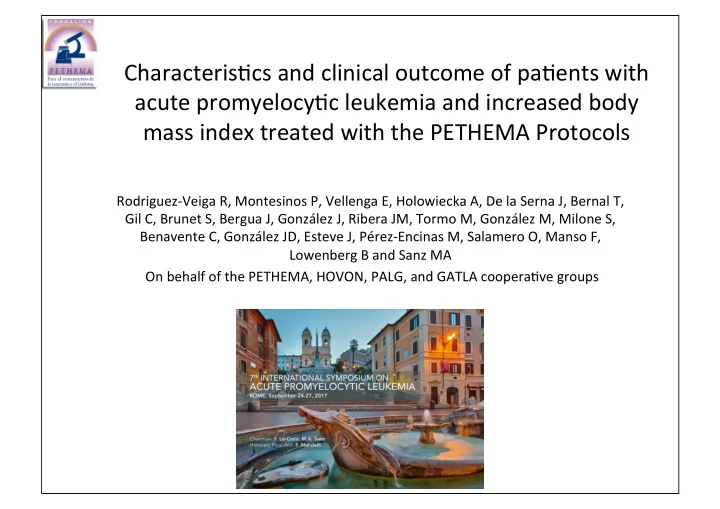

Characteris*cs and clinical outcome of pa*ents with acute promyelocy*c leukemia and increased body mass index treated with the PETHEMA Protocols Rodriguez-Veiga R, Montesinos P, Vellenga E, Holowiecka A, De la Serna J, Bernal T, Gil C, Brunet S, Bergua J, González J, Ribera JM, Tormo M, González M, Milone S, Benavente C, González JD, Esteve J, Pérez-Encinas M, Salamero O, Manso F, Lowenberg B and Sanz MA On behalf of the PETHEMA, HOVON, PALG, and GATLA coopera*ve groups
Background • Overweight and obesity was related to: – Higher incidence of differen*a*on syndrome: • Obesity (BMI ≥ 30) independent predictor of DS (n=39) • 4% in BMI<25 vs. 21% in BMI ≥ 25 (n=144) – Increase CIR at 5 years (n=144) 31.6% in BMI ≥ 25 11.2% in BMI<25 Jeddi R et al. Heatology 2010 Breccia et al. Blood 2012 Blood.
Aims Analyze in a large series of adult pa*ents (≥18 yr.) with gene*cally confirmed de novo APL, homogeneously treated with three consecu*ve mul*center PETHEMA trials: • The characteris*cs at diagnosis of overweight/obese pa*ents • The impact of BMI on clinical outcome
Material and Methods • Between 1996 and 2012, 1419 consecu*ve adult pa*ents were enrolled in the PETHEMA LPA 96, LPA 99, and LPA2005 trials • 1320 (93%) pa*ents have available height and weight data, and were included in this analysis
Material and Methods • Induc*on and consolida*on following the mul*center trials LPA96, LPA99 & LPA2005 – Induc*on: AIDA – Consolida*on � 3 risk-adapted courses • ATRA + idarrubicine or mitoxantrone ± cytarabine – Maintenance: intermiient ATRA and low dose methotrexate and 6-mercaptopurine.
Results Overweight and obesity frequency
Baseline characteristics p<0,0001
Baseline characteristics BMI < 25 BMI ≥ 25 P N= 534 N=775 Mean (range) Mean (range) Age (years) 38 (18-83) 48 (18-84) <0.0001 Crea*nine (mg/dl) 0.8 (0.3-12) 0.9 (0.2-13) <0.0001 Urea (mg/dl) 29 (8-154) 35 (8-299) <0.0001 Uric acid (mg/dl) 3.8 (0.8-11.7) 4.5 (1.1-11.6) <0.0001 Bilirrubin (mg/dl) 0.7 (0.1-3.3) 0.8 (0.1-4.3) 0.002 Cholesterol (mg/dl) 175 (52-305) 189 (76-1276) <0.0001 Triglycerids (mg/dl) 160 (39-850) 191 (22-700) <0.0001 • No differences in FLT3, BCR3, and other markers distribu*on
Clinical outcome during induction BMI < 25 BMI ≥ 25 p N= 543 N= 775 N (%) N (%) Thrombosis 29 (5) 63 (8) 0.06 Bleeding 436 (80) 608 (78) 0.5 Mortality 35 (6) 74 (10) 0.04 Differen*a*on syndrome* 143 (26) 221 (29) 0.4 DS* under/normal/overweigh vs. obese (BMI ≥ 30): 26% vs. 32% (p=0.06)
Cumulative incidence of relapse according to BMI p=0.69 13% under/normal weight 13% overweight/obese CIR at 5 years in obese (BMI ≥ 30) vs. under/normal/overweight: 13% vs. 12% (p=0.58)
Overall survival according to BMI 80% under/normal weight 74% overweight/obese p=0.006
Event-free survival according BMI 84% under/normal weight 78% overweight/obese P=0.02
Multivariate analysis Overall survival Adverse Risk factor P value Overweight/obese (BMI ≥ 25) 0.46 <0.0001 Older age <0.0001 High relapse-risk 0.001 PETHEMA trials LPA 96/99
Conclusions • We confirm the reported rela*onship between male gender, older age, and other known laboratory abnormali*es in overweight/obese pa*ents • We could not confirm the higher incidence of DS in pa*ents with BMI ≥25, but there was trend in obese pa*ents • In this large series, there was not difference in the relapse rate according BMI • The univariate analysis showed worse OS in overweight and obese pa*ents, but BMI was not an independent factor in the mul*variate analysis
Aknowledgements All the par*cipa*ng ins*tu*ons of the PETHEMA, HOVON, GATLA and PALG groups
Recommend
More recommend